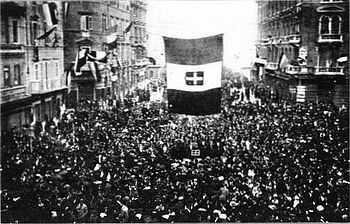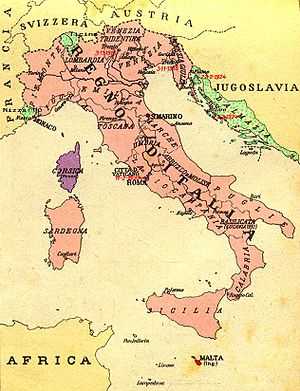Italian irredentism in Istria

Italian irredentism in Istria was the political movement supporting the unification to Italy, during the 19th and 20th centuries, of the peninsula of Istria.
History
When Napoleon defeated Venice in 1797 he found that Istria was populated by Italians on the coast and in the main cities, but the interior was populated mainly by Croats and Slovenians. This dual ethnicity of Istria created a situation of antagonism (hostility) between Slavs and Italians for the supremacy of Istria: it started with the development of the "nationalism ideals", after Napoleon's fall.[1]
During the second half of the XIX century in the Istrian peninsula -controlled by the Austrian Hasburg Empire- the Slavs and the Italians engaged in a nationalistic fight.[2]
As a consequence Istria has been the theater of an ethnic struggle between them, with bloody nationalistic wars, during the XIX and XX centuries. The Italian irredentism was actively followed by many Italians in Istria (called Istrian Italians), like the Italian hero Nazario Sauro of Capodistria (actual Koper).[3]
Indeed after 1866 -when Venice and the republic of Venice region were united to Italy- there was a strong support for Italian irredentism in Istria: Tino Gavardo, Pio Riego Gambini and Nazario Sauro were the most renowned of those who promoted Istrian unification to the Kingdom of Italy. Many of them enrolled voluntarily in the Italian Army during World War I against the Austrian Empire. Some were captured and hanged as "traitors" by the Austrians.[4]
The Italian victory in WWI gave Istria to Italy, with the full "redemption" of the requests done by the Italian irredentists for Istria.
Furthermore, the outcome of the First World War and the consequent settlement of the Treaty of Saint-Germain met some other Italian claims, including many (but not all) of the aims of the Italia irredenta party.[5] Italy gained Trieste, Gorizia, the full Istria and the city of Zara. In northern Dalmatia, despite the Treaty of London, only territories with Italian majority as Zara and some Dalmatian islands next to Istria, such as Cres (Cherso) and Lošinj (Lussino) were annexed by Italy, because Woodrow Wilson, supporting Yugoslav claims and not recognizing the Treaty, rejected Italian requests on the other Dalmatian territories.
The city of Fiume -in the Carnaro gulf next to Istria- was the subject of irredentist claims because had an Italian majority, but was not promised to Italy in the London Pact (see Italian Regency of Carnaro, Treaty of Rapallo, 1920 and Treaty of Rome, 1924) and become Italian in 1924.
The stand taken by the irredentist Gabriele D'Annunzio, which briefly led him to become an enemy of the Italian state,[6] was meant to provoke a nationalist revival through Corporatism (first instituted during his rule over Fiume), in front of what was widely perceived as state corruption engineered by governments such as Giovanni Giolitti's.
D'Annunzio briefly annexed to this "Regency of Carnaro" even the Dalmatian islands of Veglia and Arbe, where there was a numerous Italian community.
Notes
- ↑ Unredeemed Italy: Istria (Google Book)
- ↑ Benussi, Bernardo. L' Istria nei suoi due millenni di storia. p. 63
- ↑ Biography of Nazario Sauro
- ↑ Pignatti Morano, Carlo. La vita di Nazario Sauro ed il martirio dell’eroe. p.39
- ↑ ITALY'S PRICE FOR NEUTRALITY (28 March 1915) - The New York Times
- ↑ Stato Libero Di Fiume - (English: "Free State Of Fiume")
See also
Bibliography
- Alberi, Dario. Istria - Storia, arte, cultura Lint Editoriale, Trieste, 1995 ISBN 88-8190-158-7
- Bartoli, Matteo. Le parlate italiane della Venezia Giulia e della Dalmazia. Tipografia italo-orientale. Grottaferrata 1919.
- Benussi, Bernardo. L' Istria nei suoi due millenni di storia. Treves-Zanichelli. Trieste 1924.
- D'Alessio, Vanni. Il cuore conteso. Il nazionalismo in una comunità multietnica nell'Istria asburgica. Filema Edizioni, Napoli 2003
- Petacco, Arrigo. A tragedy revealed: the story of the Italian population of Istria, Dalmatia, and Venezia Giulia, 1943-1956. University of Toronto Press. Toronto, 2005 ISBN 0802039219
- Pignatti Morano, Carlo. La vita di Nazario Sauro ed il martirio dell'eroe. Fratelli Treves Editori, Milano, 1922
- Večerina, Duško. Talijanski Iredentizam ( Italian Irredentism ) ISBN 953-98456-0-2, Zagreb, 2001
- Vignoli, Giulio. I territori italofoni non appartenenti alla Repubblica Italiana. Giuffrè Editoriale. Milano, 1995.
- Vivante, Angelo. Irredentismo adriatico Venezia, 1984
| |||||||||||||||||
